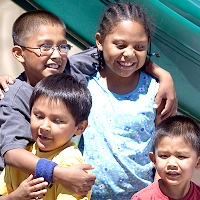Child Maltreatment
Child maltreatment includes all types of abuse and neglect of a child under the age of 18 by a parent, caregiver, or another person in a role of authority (e.g., a coach, teacher, or church leader). There are four common types of maltreatment:
How to Report Child Maltreatment
Some people are required by law to report child maltreatment . Each state and tribal governments have their own laws about who is required to report child abuse and elder abuse. There is also a federal law about reporting child abuse that occurs in Indian country.

Physical Abuse
Physical abuse occurs when a child's parent or caregiver physically assaults the child. Physical abuse can involve striking a child with a hand, foot, object, or weapon. It can also take the form of burning a child or using some other means to cause physical injury to a child. If a child is injured as the result of the parent or care giver's action, it is considered physical abuse. It does not matter if the parent or care giver intended to harm the child or not. Using spanking or paddling to discipline a child may not be considered abuse, if it is reasonable and does not harm the child.
Emotional Abuse
Emotional abuse is a pattern of behavior by a child's parent or caregiver which harms a child's emotional development or sense of self-esteem. Emotional abuse can include constant threats, criticism, or rejection. It can also involve withholding love, support, or guidance. It is often difficult to prove emotional abuse unless there is evidence that a child has suffered mental harm because of the parent or caregiver's behavior.
Sexual Abuse
Sexual abuse happens when a parent or caregiver engages in sexual behavior with a child. Sexual abuse can take many forms. It can include petting, touching or rubbing a child's genitals. It can also include sexual penetration, indecent exposure, rape, incest, showing a child pornographic, taking pornographic of a child, or encouraging a child to engage in prostitution. Sexual abuse can be committed by anyone, regardless of their gender, sexual orientation or relationship to the child.
Neglect
Neglect occurs when a parent or caregiver fails to meet a child's basic needs. Basic needs can include food, shelter, clothing, education, supervision, emotional support, and healthcare. Action to protect a child from neglect may be needed in certain cases if a child's safety is at risk. For example, if a parent is aware of resources that can be used to meet a child's basic needs, but does not use them.
IHS addresses public health problems like child maltreatment by:
- Providing direct health care and behavioral health services for patients;
- Providing funding for demonstration projects;
- Developing, implementing, and monitoring health policy; and
- Training providers in the Indian health system to respond to child maltreatment.
Resources
- Childhelp National Child Abuse Hot Line
1-800-4-A-CHILD (1-800-422-4453) - Indian Health Manual Part 3, Chapter 13 Maternal and Child Health
- Indian Health Manual Part 3, Chapter 20 Protecting Children from Sexual Abuse by Health Care Providers
- Indian Health Manual Part 3, Chapter 36 Child Maltreatment
- A National Protocol for Sexual Assault Medical Forensic Examinations, Pediatric [PDF - 2.1 MB]
- National Children's Alliance — National Standards of Accreditation for Children's Advocacy Centers 2023 Edition [PDF - 2.2 MB]
- Children's Bureau, an Office of the Administration for Children & Families


